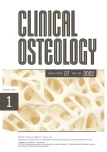Involvement of growth factors in molecular effects of ibuprofen in dental pulp stem cells
Autoři:
Adamičková Adriana 1; Adamička Matúš 2; Gažová Andrea 3; Kyselovič Ján 1,4
Působiště autorů:
Institute of Medical Biology, Genetics and Clinical Genetics, Faculty of Medicine, Comenius University Bratislava, Slovakia
2; Institute of Pharmacology and Clinical Pharmacology, Faculty of Medicine, Comenius University Bratislava, Slovakia
3; Department of Pharmacology and Toxicology, University of Veterinary Medicine and Pharmacy in Košice, Slovakia
4; th Department of Internal Medicine, Faculty of Medicine, Comenius University Bratislava, and University Hospital, Bratislava – Hospital Ružinov, Bratislava, Slovakia
15
Vyšlo v časopise:
Clinical Osteology 2022; 27(1): 26-29
Kategorie:
Přehledové články
Souhrn
Stem cells represent promising candidates for regenerative therapy of craniomaxillofacial bone defects, where common techniques, such as autogenous bone graft, allografts or others possess shortcomings and limitations in restoring the morphology and function in bone loss. The efficacy of regenerative therapy with mesenchymal stromal cells (MSC) depends on a combination of the interactions between transplanted MSCs and cellular and molecular components of the recipient, and any current pharmacotherapy in the recipient with effects on transplanted MSC and the bone microenvironment. In the present investigation, dental pulp stem cells (DPSC) were isolated from human impacted third molar teeth. DPSC were treated with ibuprofen in vitro at clinically relevant concentration and relative expression of selected genes were assessed. Our preliminary data suggest a significant effect of ibuprofen as indicated by upregulation of the relative expression levels of growth factors, vascular endothelial growth factor (VEGF) and hepatocyte growth factor (HGF). While the effects of stem cell therapy in bone regeneration are being investigated in ongoing clinical trials, the effects of commonly used pharmacotherapy should be studied for its potential impact on the paracrine effects of stem cells and consequently bone regenerative processes.
Zdroje
1. Sui B-D, Hu C-H, Liu A-Q et al. Stem cell-based bone regeneration in diseased microenvironments: Challenges and solutions. Biomaterials 2 019; 196: 18–30. A vailable from DOI: < https://doi.org/10.1016/j. biomaterials.2017.10.046>.
2. Aimetti M, Ferrarotti F, Gamba MN et al. Regenerative Treatment of Periodontal Intrabony Defects Using Autologous Dental Pulp Stem Cells: A 1-Year Follow-Up Case Series. Int J Periodontics Restorative Dent 2018; 38(1): 51–58. Available from DOI: <https://doi.org/10.11607/prd.3425>.
3. Ferrarotti F, Romano F, Gamba MN et al. Human intrabony defect regeneration with micrografts containing dental pulp stem cells: A randomized controlled clinical trial. J Clin Periodontol 2018; 45(7): 841– 850. Available from DOI: <https://doi.org/10.1111/jcpe.12931>.
4. Nakashima M, Iohara K, Murakami M et al. Pulp regeneration by transplantation of dental pulp stem cells in pulpitis: a pilot clinical study. Stem Cell Res Ther 2017; 8(1): 61. Available from DOI: <https://doi.org/10.1186/s13287–017–0506–5>.
5. Bauer SM, Bauer RJ, Velazquez OC. Angiogenesis, Vasculogenesis, and Induction of Healing in Chronic Wounds. Vasc Endovascular Surg 2005; 39(4): 293–306. Available from DOI: <https://doi.org/10.1177/153857440503900401>.
6. Sulpice E, Ding S, Muscatelli-Groux B et al. Cross-talk between the VEGF-A and HGF signalling pathways in endothelial cells. Biol Cell 2009; 101(9): 525–539. Available from DOI: <https://doi.org/10.1042/BC20080221>.
7. Malhotra A, Pelletier MH, Yu Y, Walsh WR. Can platelet-rich plasma (PRP) improve bone healing? A comparison between the theory and experimental outcomes. Arch Orthop Trauma Surg 2013; 133(2): 153–65. Available from DOI: <https://doi.org/10.1007/s00402–012–1641–1>.
8. Zhai Q, Dong Z, Wang W et al. Dental stem cell and dental tissue regeneration. Front Med 2019; 13(2): 152–9. Available from DOI: <https://doi.org/10.1007/s11684–018–0628-x>.
9. Dominici M, Le Blanc K, Mueller I et al. Minimal criteria for defining multipotent mesenchymal stromal cells. The International Society for Cellular Therapy position statement. Cytotherapy 2006; 8(4): 315–317. Available from DOI: <https://doi.org/10.1080/14653240600855905>.
10. Jiang W, Xu J. Immune modulation by mesenchymal stem cells. Cell Prolif 2 020; 5 3(1): e 12712. Available from DOI: <https://doi.org/10.1111/cpr.12712>.
11. Chang J-K, Li C-J, Wu S-C et al. Effects of anti-inflammatory drugs on proliferation, cytotoxicity and osteogenesis in bone marrow mesenchymal stem cells. Biochem Pharmacol 2007; 74(9): 1371–1382. Available from DOI: <https://doi.org/10.1016/j.bcp.2007.06.047>.
12. Fu X, Tan T, Liu P. Regulation of Autophagy by Non-Steroidal Anti- Inflammatory Drugs in Cancer. Cancer Manag Res 2020; 12: 4595– 4604. Available from DOI: <https://doi.org/10.2147/CMAR.S253345>.
13. Almaawi A, Wang HT, Ciobanu O et al. Effect of Acetaminophen and Nonsteroidal Anti-Inflammatory Drugs on Gene Expression of Mesenchymal Stem Cells. Tissue Eng Part A 2013; 19(7–8): 1039–1046. Available from DOI: <https://doi.org/10.1089/ten.tea.2012.0129>.
Štítky
Biochemie Dětská gynekologie Dětská radiologie Dětská revmatologie Endokrinologie Gynekologie a porodnictví Interní lékařství Ortopedie Praktické lékařství pro dospělé Radiodiagnostika Rehabilitační a fyzikální medicína Revmatologie Traumatologie OsteologieČlánek vyšel v časopise
Clinical Osteology

2022 Číslo 1
- Tirzepatid – nová éra v léčbě nadváhy a obezity
- MINISERIÁL: Když ženám stoupá tlak...
- Není statin jako statin aneb praktický přehled rozdílů jednotlivých molekul
Nejčtenější v tomto čísle
- Chondroblastóm femuru – benígny nádor s potenciálne vážnymi následkami: kazuistika
- Casus socialis: sociálny či medicínsky problém? Kazuistika
- Změny kostní denzity a riziko osteoporotických fraktur u pacientů s psoriatickou artritidou
- A need for predictive and personalized approach in osteoporosis treatment: individual treatment plan
